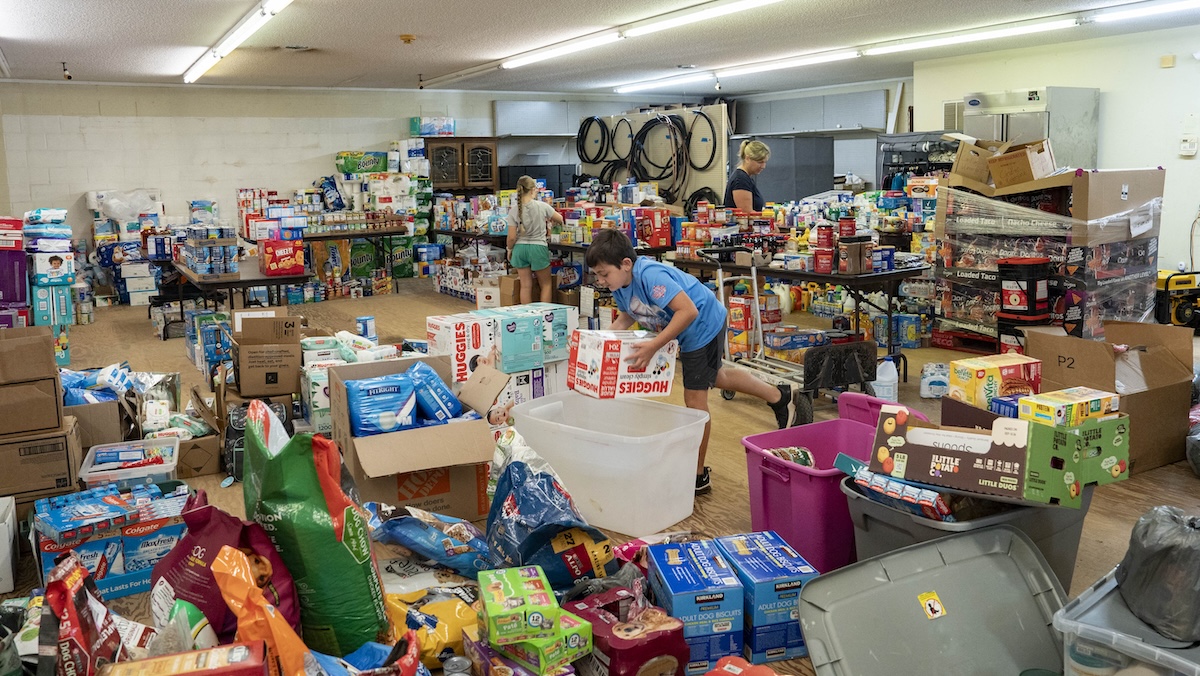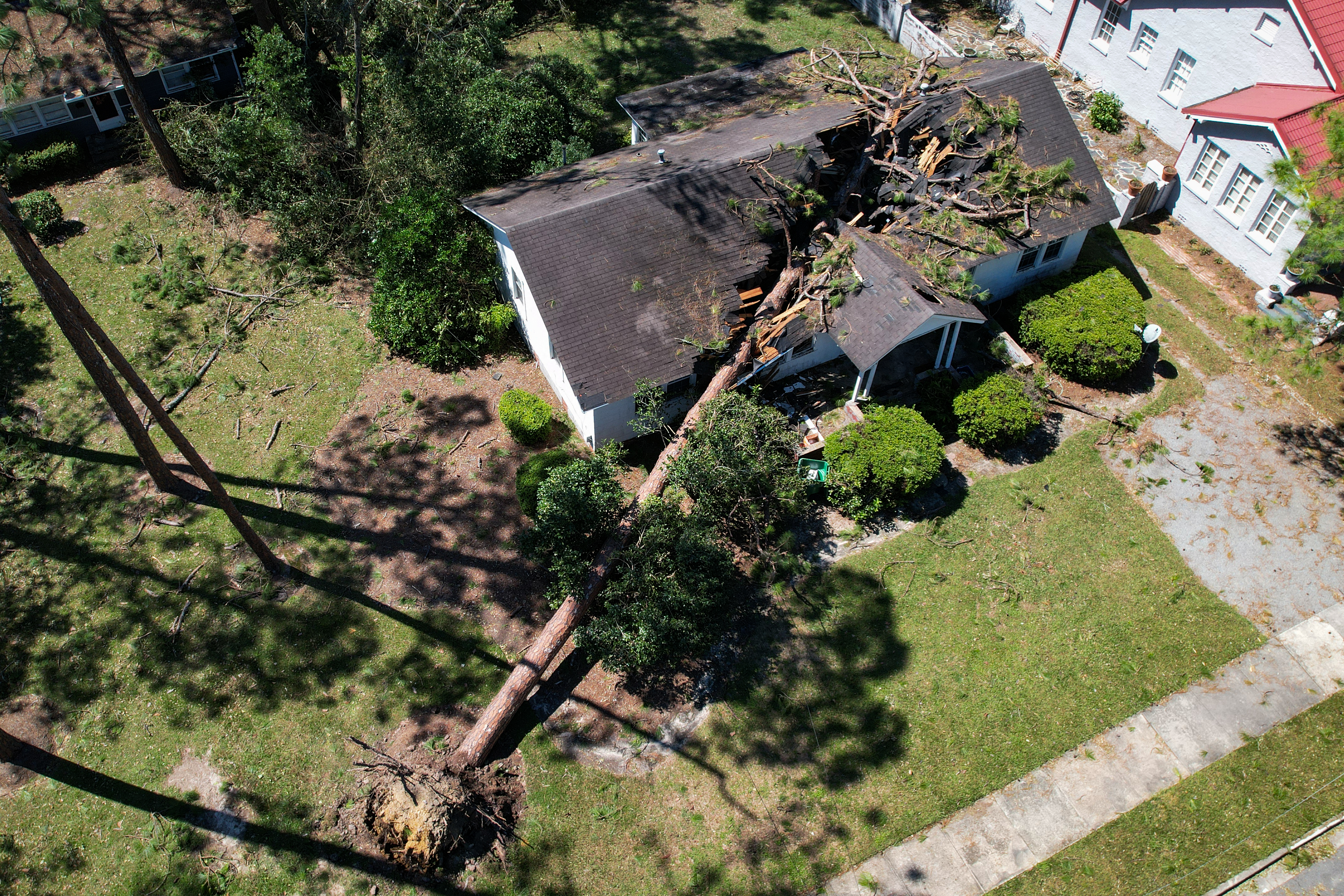Cadaver dogs and search crews trudged through knee-deep muck and debris in the mountains of western North Carolina on Tuesday looking for victims of Hurricane Helene, days after the storm carved a deadly and destructive path through the Southeast.
With Helene's death toll topping 150, searchers fanned out, using helicopters to get past washed-out bridges and hiking through wilderness to reach isolated homes.
The storm, which was one of the deadliest in U.S. history, knocked out power and cellular service in some towns and cities, leaving many people frustrated, hot and increasingly worried days into the ordeal. Some cooked food on charcoal grills or hiked to high ground in the hopes of finding a signal to call loved ones.
In Augusta, Georgia, Sherry Brown was converting power from the alternator of her car to keep her refrigerator running and taking “bird baths” with water she collected in coolers. In another part of the city, people waited in line more than three hours to try to get water from one of five centers set up to serve more than 200,000 people.
We've got the news you need to know to start your day. Sign up for the First & 4Most morning newsletter — delivered to your inbox daily. Sign up here.
The devastation was especially bad in the Blue Ridge Mountains, where at least 57 people died in and around Asheville, a tourism haven known for its art galleries, breweries and outdoor activities.
“Communities were wiped off the map,” North Carolina’s governor, Roy Cooper, said at a news conference Tuesday.
The devastation was especially bad in the Blue Ridge Mountains, where at least 50 people died in and around Asheville, a tourism haven known for its art galleries, breweries and outdoor activities.
In Swannanoa, a small community outside Asheville, receding floodwaters revealed cars stacked on top of others and trailer homes that had floated away during the storm. Roads were caked with mud and debris and pockmarked by sinkholes.
Cliff Stewart survived two-feet of water that poured into his home, topping the wheels on his wheelchair and sending his medicine bottles floating from room to room. Left without power and reliant on food drop-offs from friends, he has refused offers to help him leave.
“Where am I going to go?" the Marine Corps veteran said Tuesday. “This is all I’ve got. I just don’t want to give it up, because what am I going to do? Be homeless? I’d rather die right here than live homeless.”
Exhausted emergency crews worked around the clock to clear roads, restore power and phone service, and reach those still stranded by the storm, which killed at least 150 people in six states, including many who were hit by falling trees or trapped in flooded cars and homes. Nearly half of the deaths were in North Carolina, while dozens of others were in South Carolina and Georgia.
President Joe Biden was set to survey the devastation in North and South Carolina Wednesday.
More than 150,000 households have registered for assistance with the Federal Emergency Management Agency, and that number is expected to rise rapidly in the coming days, said Frank Matranga, an agency representative.
Nearly 2 million ready-to-eat meals and more than a million liters of water have been sent to the hardest-hit areas, he said.
Search crews around Asheville first checked on the most vulnerable.
“We’ve been going door to door, making sure that we can put eyes on people and see if they’re safe,” said Avril Pinder, the county manager for Buncombe County, which includes Asheville. “We know that there are places that are still hard to access.”
How some of the hardest-hit areas are coping
The storm unleashed the worst flooding in a century in North Carolina, dumping more than an estimated 2 feet of rain in places.
Cooper said Tuesday that more than two dozen water plants remained closed and were not producing water.
Active-duty U.S. military units may be needed to assist the long-term recovery, he said, adding that Biden had given “the green light” to mobilizing military assets in the near future.
A section of one of the region's main arteries, Interstate 40, reopened Tuesday after a mudslide was cleared, but a collapsed stretch near North Carolina's border with Tennessee remained closed.
Residents and business owners wore masks and gloves while clearing debris Tuesday in Hot Springs, where almost every building along the tiny town's main street was heavily damaged.
Sarah Calloway, who owns the deli and gourmet grocery Vaste Riviere Provisions, said the storm arrived in town frighteningly quickly. She helped fill sandbags the day the night before, but they turned out to be useless. The water rose so rapidly that even though she and others were in an apartment on an upper floor, she feared they would not be safe. They called to request a rescue from a swift water team.
“They tried to get to us, and at that point they couldn’t,” she said. “Luckily, that was when the water started to recede.”
“It was really challenging to watch how quickly it rose up and then just to watch whole buildings floating down the river. It was something I can’t even describe,” she said.
Helene blew ashore in Florida late Thursday as a Category 4 hurricane and upended life throughout the Southeast, where deaths were also reported in Florida, Tennessee and Virginia. Officials warned that rebuilding would be long and difficult.
Mobile service knocked out
The widespread damage and outages affecting key communications infrastructure left many people without stable access to the internet and cellular service, the Federal Communications Commission said.
Teams from Verizon were working to repair downed cell towers, damaged fiber cables and provide alternative forms of connectivity across the region, the company said in a statement.
AT&T, meanwhile, said it launched “one of the largest mobilizations of our disaster recovery assets for emergency connectivity support.”
The efforts to restore service was made more challenging by the region’s terrain and spread-out population, said David Zumwalt, president and CEO of the Association for Broadband Without Boundaries.
Why western North Carolina was hit so hard
Remnants of Helene encountered the higher elevations and cooler air of the Appalachian Mountains, causing even more rain to fall.
Asheville and many surrounding mountain towns were built in valleys, leaving them especially vulnerable to rain and flooding. Plus, the ground already was saturated before Helene arrived, said Christiaan Patterson, a meteorologist with the National Weather Service.
Climate change has exacerbated conditions that allow such storms to thrive, rapidly intensifying in warming waters and turning into powerful cyclones, sometimes within hours.
Destruction from Florida to Virginia
Across Georgia, Helene’s inland path knocked out power and shattered lives from Valdosta to Augusta, where a line of cars waiting to get water Tuesday wrapped around a shopping center and stretched at least a half-mile down the road.
“It’s been rough,” said Kristie Nelson, who had no idea when her electricity would be restored. “I’m just dying for a hot shower.”
Tennessee Gov. Bill Lee flew to the eastern part of that state to survey damage on Tuesday. During a stop while looking at what remained of a demolished high school, residents said the governor and his entourage were the first help they had seen since the storm hit.
“Where has everyone been? We have been here alone,” one frustrated local said.
With at least 36 killed in South Carolina, Helene passed the 35 people who were killed in the state after Hurricane Hugo made landfall north of Charleston in 1989.
Kirk becomes a hurricane and could strengthen into a major storm
Kirk on Tuesday became a hurricane in the eastern Atlantic Ocean. The storm could strengthen into a major hurricane by Thursday, the U.S. National Hurricane Center said. The storm was about 1070 miles (1,720 kilometers) west of the Cabo Verde Island with maximum sustained winds of 75 mph (120 kph). There were no coastal watches or warnings in effect, and the storm system was not yet deemed a threat to land.
___
Contributing to this report were Associated Press journalists Gary D. Robertson in Raleigh; Kimberlee Kruesi in Hampton, Tennessee; Jeffrey Collins in Augusta, Georgia; John Raby in Charleston, West Virginia; Rebecca Santana in New Orleans; Shawn Chen in New York; and John Seewer in Toledo, Ohio.




